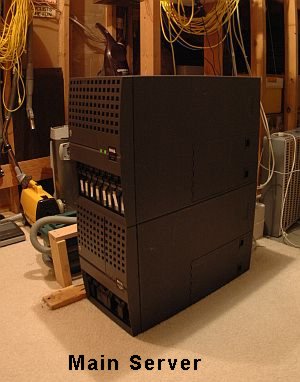NOTE: This page was originally posted around 2002 so the details are very out of date.
This is another page which began as the answer to an e-mail question, so it may seem a bit disjointed. I'm including it for informational purposes and will gradually clean and improve it as the mood strikes. The purpose of this page is to give some ideas of how fast a computer you might need to run a webcam and what kind of bandwidth might be taken up by your webcam.
 As you might have surmised, my webcam page has become very popular. The most popular search engines now show me as either number one in the list or within the top few links. As of this posting, my webcam review pages average around 22,000 visitors a month. While my website is hosted professionally, my camera images come directly from a server in my house. My snapshot cameras tend to serve out around 400,000 images a month which comes to roughly two gigs of bandwidth. My cable internet connection gives me a 1.5 meg upstream capability but it is seldom stressed except when I have someone pulling a really big file from my in-house server. I do that when I have multi meg files to send to someone which won't attach to e-mail messages easily. I store the file on my in-house web server, the same one that serves my camera images, and send the person a link to the file which they can download using their web browser. I currently have no way to measure the bandwidth usage from the streaming camera.
As you might have surmised, my webcam page has become very popular. The most popular search engines now show me as either number one in the list or within the top few links. As of this posting, my webcam review pages average around 22,000 visitors a month. While my website is hosted professionally, my camera images come directly from a server in my house. My snapshot cameras tend to serve out around 400,000 images a month which comes to roughly two gigs of bandwidth. My cable internet connection gives me a 1.5 meg upstream capability but it is seldom stressed except when I have someone pulling a really big file from my in-house server. I do that when I have multi meg files to send to someone which won't attach to e-mail messages easily. I store the file on my in-house web server, the same one that serves my camera images, and send the person a link to the file which they can download using their web browser. I currently have no way to measure the bandwidth usage from the streaming camera.
Take a look at a single image from your camera. How large is the file in bites? Now consider how many people might be watching at the same time. How fast is your refresh rate? Multiply the 3 numbers together, then multiply that by 8. That should give you an idea of the bandwidth you will need to serve your snapshot webcam from your house or business.
For streaming a camera directly from your computer, you will definitely need a high speed Internet connection. A 320x240 pixel image refreshing at 15 frames a second will take something between 76k to 128k of your upstream bandwidth, per viewer. Higher quality images will take more.
Side note: Consumer Reports had an interesting article on high speed Internet providers in their June (or was it July) 2005 issue. They recommended that if Direcway was the only high speed Interment service you have available, get dial up instead. I work with 2 people who have Direcway and I tend to agree. I am finding that Direcway gives a better downstream speed for browsing web sites than dial up, but its upload speed can be extreamly slow. The last time I was at the Country Waye I was trying to upload a correction on my webcam index page (42k). After 2 hours I gave up and found a dial up connection which took only 15 seconds.
It is good to understand that the newer the camera, the faster the computer needs to be. The newer cameras have less in the way of internal maniuplatitive circurity, relying more on the computer to process the data. However, most have better imageing sensors. As long as you are only doing a snapshot upload, a 5 year old machine should be able to handle any of the cameras except for the very latest ones.
Most of the minimum system requirements listed for the cameras assume you will be using the included software and want to have some computer recourses left to do something else. An oldder machine will do just fine if it is dedicated just to the webcam, and doesn't have to stream the image itself. Just make sure that the older machine has MMX capability. My back yard JVC video camera is running on a very old computer (pre MMX) just because I have a video capture card in that machine. None of the other webcams will run on that machine because they require the MMX codes to operate.